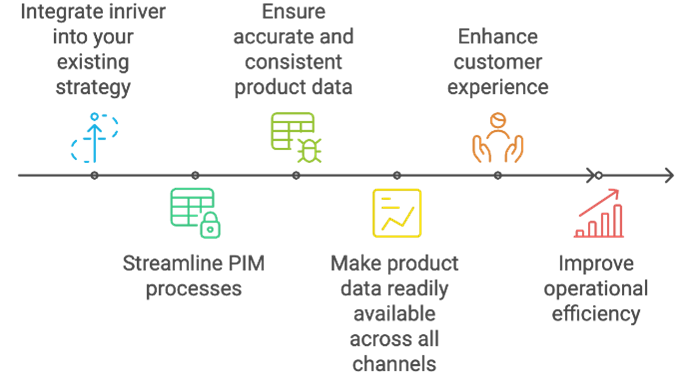In today’s digital landscape, efficiently managing product information is vital for businesses to enhance customer satisfaction and drive sales growth. A robust Product Information Management (PIM) system with excellent integration features, like inriver, will streamline your PIM strategy. By utilizing the integration frameworks and APIs provided by inriver, businesses can ensure relevant, accurate, and consistent product information across all channels. This article explores key inriver integration techniques that have the potential to transform your PIM approach.
The importance of PIM Integration –
Automating PIM processes leads to significant improvements in efficiency, accuracy, and scalability. By eliminating manual data entry, automated integration reduces errors and ensures that information remains consistent and current across all systems. This not only saves time and cuts labor costs but also enhances business agility and customer satisfaction. With automated integration, companies can swiftly adapt to market changes, make informed decisions, and provide timely, personalized information to their customers.

Exploring inriver Integration Options –
There are several ways to automate the integration between systems that are used to send or receive data –
Leveraging APIs (application programming interface)-
- inriver REST APIs – These can be utilized to build integrations in any programming language and customize interfaces within inriver, including creating enriched PDF/Preview templates.
- inriver Remoting APIs – These require C# programming knowledge and are used with hosted solutions. The Remoting API services consist of six major components:
- Channel Service – Methods related to channels. e.g. Channel Structure, Publish/Unpublish a channel, Retrieve entities and links from a channel etc.
- Data Service – One of the most widely used Service for creating, updating, deleting and finding entities and links in the system.
- Model Service – Contains methods for building and maintaining PIM data model.
- Print Service – Used for developing the inriver print plugin.
- User Service – Provide methods for maintaining uses, role, permissions and restrictions.
- Utility Service – Contains various method including Connector states, HTML Templates, Languages, and Notifications.

Remoting Services
- Content API – A set of APIs designed to facilitate the onboarding and distribution of large volume of product data.
- Content Onboarding API – help standardize the data onboarding process by dividing them into five key steps – Landing Area, Field Mapping, Staging area, PIM validations and Import.
- Content Delivery API – used for distribution of product data to various channels and platforms, ensures that product data is uniform across all channels.
Integration Framework (IIF) – The Integration Framework is a foundation for building adapters and outbound integrations in inriver. It transforms customer’s unique data model into a standard integration model. It supports custom entity types, delta functionality and provide standard functions to deliver product data.

High level integration framework flow
The following table highlights the key aspects when considering integration within inriver –
| Feature/Aspect | REST API | Remoting API | inriver Integration Framework (IIF) | Content API |
| Functionality | Basic to advance functionality | Extensive functionality | Outbound integrations | Build on IIF, Standardizes inbound and outbound data handling |
| Programming Language | Technology-agnostic | Requires C# programming | Requires C# programming | Technology-agnostic |
| Use Cases | Remote solutions | Hosted solutions, advanced operations | Exporting data to storefronts, building adapters | Onboarding product data, distributing product data |
| Performance | Better performance for remote solutions | Better performance for hosted solutions | Efficient for outbound data handling | Efficient for both inbound and outbound data handling |
| Flexibility | High flexibility, suitable for various platforms | Less flexible, specific to inriver environment | Moderate flexibility, decouples standard adapters | High flexibility, suitable for various platforms |
| Scalability | Highly scalable | Scalable within inriver cloud service | Scalable for outbound integrations | Highly scalable |
| Common Applications | eCommerce platforms, CMS, BI tools | ERP systems, custom extensions | eCommerce platforms, Marketplaces | Supplier onboarding, ERP, content distribution |
These integration techniques can significantly enhance your PIM strategy, ensuring your product data remains accurate, consistent, and up to date across all channels. At Perficient, we engage in comprehensive discussions throughout our elaboration process and continue to validate during implementation phase. We help finalize best practices tailored to each customer’s unique needs, recognizing that one approach may work better for one client than another. Get in touch to explore how we can support you on your PIM implementation journey, whether you’re starting fresh or facing challenges with an existing system.

Great insights on PIM strategy! Integrating inriver effectively is such a game-changer for managing product information. I really appreciate the emphasis on streamlining—it’s easy to overlook how much smoother workflows can be with the right approach. These techniques make a complex process feel a lot more manageable, especially for teams dealing with massive product data. Looking forward to trying some of these tips out.
Thanks for your kind words! I’m glad you found the insights on PIM strategy useful. Excited for you to try out these tips! Let me know how it goes, and if you have any questions, feel free to reach out. Happy optimizing!